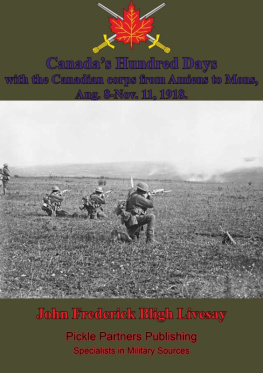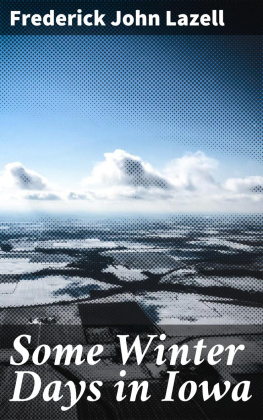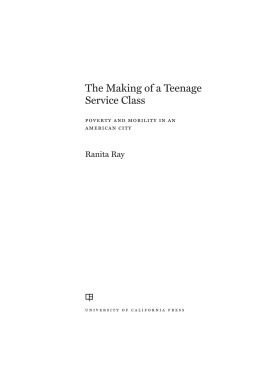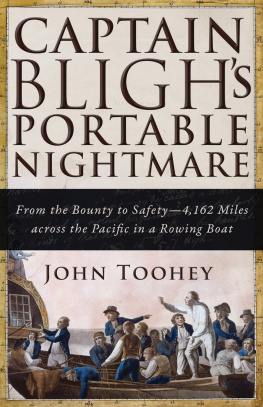John Frederick Bligh Livesay - Canadas Hundred Days
Here you can read online John Frederick Bligh Livesay - Canadas Hundred Days full text of the book (entire story) in english for free. Download pdf and epub, get meaning, cover and reviews about this ebook. year: 2013, publisher: Pickle Partners Publishing, genre: Non-fiction. Description of the work, (preface) as well as reviews are available. Best literature library LitArk.com created for fans of good reading and offers a wide selection of genres:
Romance novel
Science fiction
Adventure
Detective
Science
History
Home and family
Prose
Art
Politics
Computer
Non-fiction
Religion
Business
Children
Humor
Choose a favorite category and find really read worthwhile books. Enjoy immersion in the world of imagination, feel the emotions of the characters or learn something new for yourself, make an fascinating discovery.
- Book:Canadas Hundred Days
- Author:
- Publisher:Pickle Partners Publishing
- Genre:
- Year:2013
- Rating:3 / 5
- Favourites:Add to favourites
- Your mark:
- 60
- 1
- 2
- 3
- 4
- 5
Canadas Hundred Days: summary, description and annotation
We offer to read an annotation, description, summary or preface (depends on what the author of the book "Canadas Hundred Days" wrote himself). If you haven't found the necessary information about the book — write in the comments, we will try to find it.
Canadas Hundred Days — read online for free the complete book (whole text) full work
Below is the text of the book, divided by pages. System saving the place of the last page read, allows you to conveniently read the book "Canadas Hundred Days" online for free, without having to search again every time where you left off. Put a bookmark, and you can go to the page where you finished reading at any time.
Font size:
Interval:
Bookmark:


This edition is published by PICKLE PARTNERS PUBLISHING www.picklepartnerspublishing.com
To join our mailing list for new titles or for issues with our books contact@picklepartnerspublishing.com
Text originally published in 1919 under the same title.
Pickle Partners Publishing 2013, all rights reserved. No part of this publication may be reproduced, stored in a retrieval system or transmitted by any means, electrical, mechanical or otherwise without the written permission of the copyright holder.
Publishers Note
Although in most cases we have retained the Authors original spelling and grammar to authentically reproduce the work of the Author and the original intent of such material, some additional notes and clarifications have been added for the modern readers benefit.
We have also made every effort to include all maps and illustrations of the original edition the limitations of formatting do not allow of including larger maps, we will upload as many of these maps as possible.
Canada s Hundred Days
With the Canadian Corps from Amiens to Mons, Aug. 8 Nov. 11, 1918.
By
J. F. B. Livesay
With Portrait and Maps

Contents
CHAPTER ITHE SITUATION ON THE WEST FRONT
Sir Arthur W. Currie, K.C.B., K.C.M.G., Canadian Corps Commander
Map to illustrate Battle of Amiens
Map to illustrate Battles of Arras and Cambrai
Map to illustrate operations, Cambrai to Mons
THIS book has been written to give the Canadian people a clearer, fuller, conception of the wonderful work of the Canadian Corps during the Hundred Days. To that consideration every other has been subordinated.
By identifying so far as possible the actual battle position of individual battalions it is hoped to stimulate local pride and interest in their respective territorial or recruiting areas. Difficulties were here encountered, both through absence of detailed official narratives and limitations of space, but if full justice has not been done each fighting unit, it is not from lack of application and goodwill.
With this prime consideration always in mind, it has been sought to make the book intelligible to the general reader as well as to the military student and pains therefore have been taken to explain at length for the former military technicalities and terminology that come within the common knowledge of the latter.
Whenever practicable the original and official sources drawn upon for description of operations have been quoted. Such may at times be a little tedious but is preferable to loose paraphrasing which, while denying the reader an inspection of the documentary evidence, makes heavy drafts upon his credulity. Thus the Official Report of the Corps Commander covering these operations has been reproduced practically in full, paralleling in its proper place the general narrative. This might be expected to make for confusion and overlapping, but in practice it has not altogether worked out that way, for whereas the Official Report deals mainly with technical aspects, the book itself seeks to clothe these with the pulsating life and color of the battlefield. The alternatives must have been either to have . buried the Official Report in a lengthy Appendix, or to have omitted it altogether. It is felt the right course has been followed because whatever the book may suffer from these occasional breaks in the story, this loss is overwhelmingly counter-balanced by placing before the reader in an accessible form this extremely valuable and compellingly interesting report, carrying with it the authority of an authenticated historic document.
Among official or semi-official narratives of which free use has been made are those of the 1st Canadian Division, the 4th Canadian Division, the 4th Canadian Infantry Brigade, as well as several battalion narratives. Valuable material has been drawn from the narrative of the First Army, published by the London Times, entitled, The Final Blow of the First Army in 1918.
The author is greatly indebted to a number of friends of all ranks in the Canadian Corps for information and suggestions. Special acknowledgement must be made of the very efficient work of Lieut. J. I. P. Neal, Canadian Corps Survey Section, who throughout these operations superintended the Corp Maps Section, and has now prepared the accompanying maps and plans.
WINNIPEG, CANADA, AUG. 26, 1919.
J.F.B.L.
ON July 18, 1918, Marshal Foch, supported by new American levies, struck his hammer blow on the Marne. We shall hear a good deal in history of Chateau Thierry and the great victory, but it remains that at the end of July the West Frontthe traditional West Front of Flanders, Picardy and the Sommewas intact, unpierced, to all seeming an impregnable wall built by German blood and iron. But it was not the line of 1917. The spring offensive had cramped its defenders into a narrower, a more perilous ring. In the north the enemy bivouacked on the field of Passchendaele and from Mount Kemmel, cast his shadow over the Channel ports; to the south he was knocking at the gate of Amiens and thrusting through Montdidier at Paris; only in the centre, at Souchez, on Vimy Ridge and before Arras, where through all those fateful days of March and April the Canadian Corps had kept watch and guard, the line of 1917 stood firm.
There is abundant evidence that at the end of July, while the enemy regarded the situation in the south as serious and was preparing to admit that his last great offensive had failed, he still held the West Frontthe Somme, the Hindenburg Line and the valley of the Lysto be invincible, and counted on the British armies frittering away their strength upon its formidable defenses as they had in 1916 and 1917. Further than that, he had actually in preparation a new offensive on the Amiens-Montdidier front with which he hoped to restore the military balance in his favor. It was only after the Battle of Amiens, in which the Canadian Corps took so glorious and leading a part, that he began to despair.
Ludendorff clearly admits this in his book. The defeat of our arms on Aug. 8 in the Franco-British offensive near Albert and north of Montdidier finally resulted in our losing hope for a military victory, he writes. Conferences were held with Chancellor von Hertling, Admiral von Hintz, the foreign minister, and Field Marshal von Hindenburg, on Aug. 14, 15 and 16, and there was also a meeting of the Crown Council at which I clearly stated that the war could not be won militarily.
The kick-off of Aug. 8 at Amiens was the first general offensive attempted by the British armies in 1918, and the events leading up to it must be briefly rehearsed in order to get a true strategic picture. This can best be done in the words of Field-Marshal Haig, as contained in his famous Victory Dispatch of Dec. 21, 1918. After describing the weakened condition of the forces at his command following the enemy offensive, he says:The German attacks, though they had failed to break the Allied line, had stretched the resources of the Allies to the uttermost; while before Amiens and Hazebrouck they had brought the enemy within a short distance of strategic points of great importance. In these circumstances the possibility of an immediate renewal of the enemys offensive could not but be viewed with grave anxiety....
Next pageFont size:
Interval:
Bookmark:
Similar books «Canadas Hundred Days»
Look at similar books to Canadas Hundred Days. We have selected literature similar in name and meaning in the hope of providing readers with more options to find new, interesting, not yet read works.
Discussion, reviews of the book Canadas Hundred Days and just readers' own opinions. Leave your comments, write what you think about the work, its meaning or the main characters. Specify what exactly you liked and what you didn't like, and why you think so.










